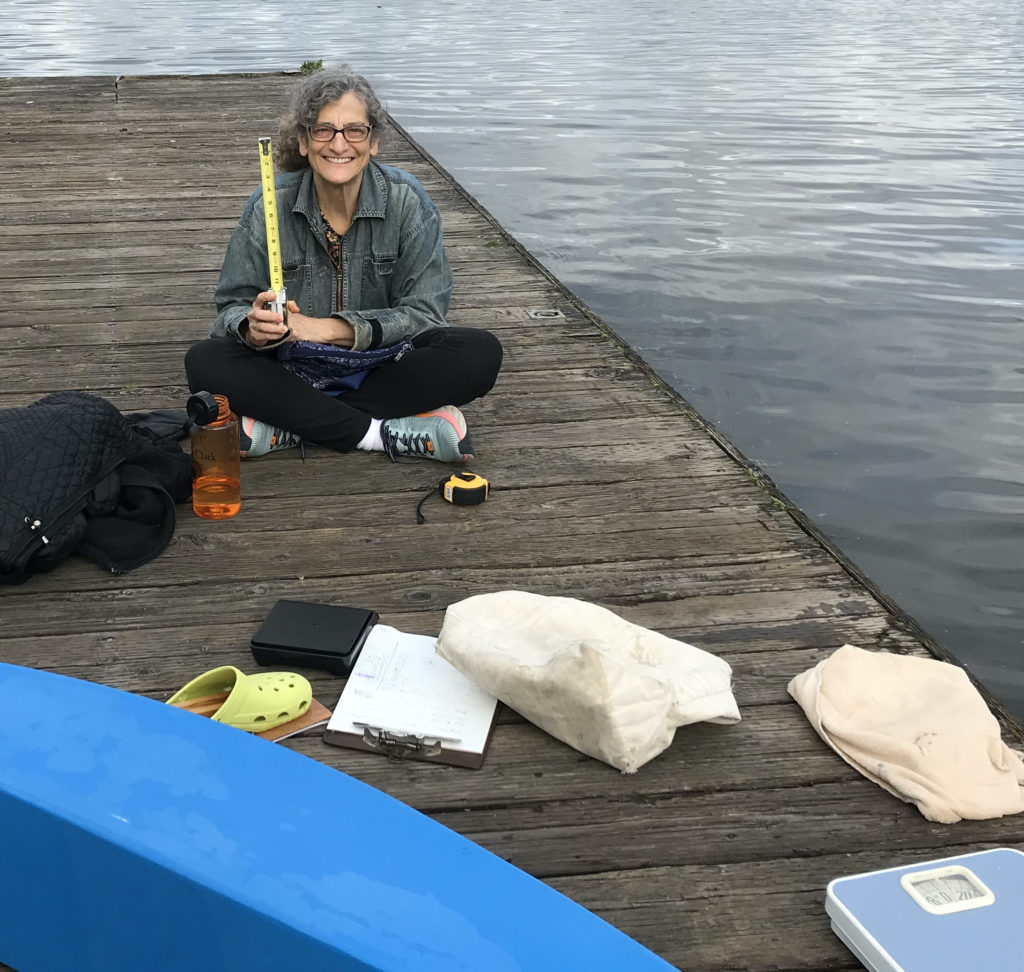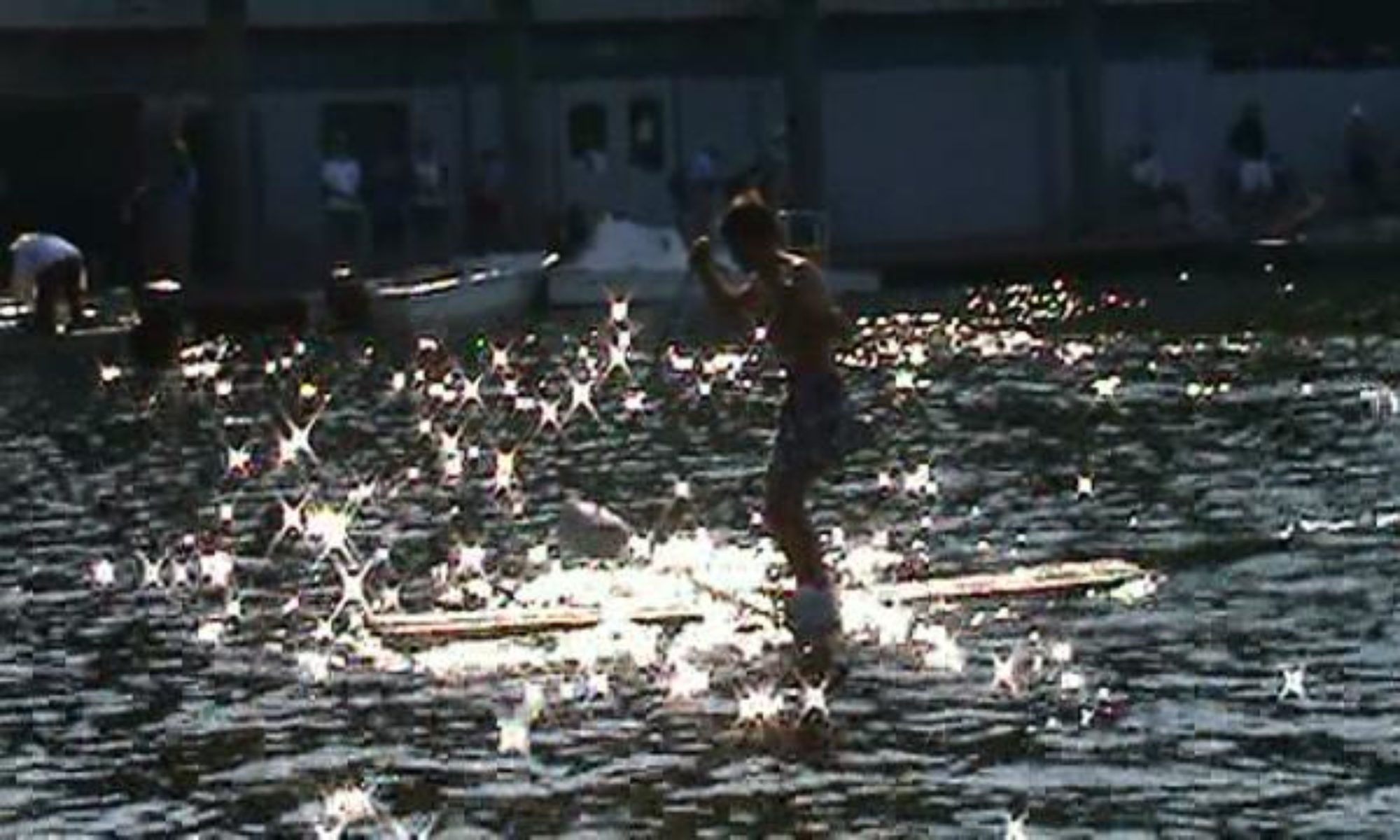Archimedes Maiden Voyage occurred as scheduled on April 18, 2021. I’ve got good news and bad news. First the good news: SHE FLOATED. Also, a nice crowd of people came and enjoyed drinks and snacks while watching the spectacle. And of course, Archimedes looked good.
Now the bad news. V3 performance was nowhere as good as V2. I’d say, they barely functioned. I’m going to outline a detailed analysis of the problems and how I’m thinking to address some of them later in this post. I’d be grateful for your feedback and suggestions. First, here is some video footage from the maiden voyage.
The remainder of this post will be a detailed post-mortem on the failings along with a proposed path forward.
Issues
Radical innovation vs. incremental improvement
I need to remind myself how we got here before continuing with the list issues. I had used my V2 skis again last summer after a 10 year break. I made only a couple of minor adjustments and had them working pretty good. I went further and faster than ever, crossing Union Bay in about 20 minutes. Remembering the fun we had 10 years ago, I decided it would be worth taking the “next step”. I thought that would be improving ease-of-use, making them faster, and making it easier to measure the effects of configuration adjustments such as paddle length and blade size. I also wanted to be able to make them work for a wider spectrum of skier body sizes and abilities. Lastly, though I had abandoned the thought of seeking a patent, I still wanted to make something that could become a product or look like a product.
I had no idea of how my new skis would be constructed at the end of last summer. I had always realized that boat hull construction could be an alternative to floatation construction as the V1 milk carton skis or V2 styrofoam skis had been. I found the stitch-and-glue technique and thought it would offer a light weight and customizable solution. The entire ski would offer floatation, unlike the V2 cockpit that fills up with water. I came up with the banana shape while trying to figure out how to bring the skiers feet closer together (less bow legged) and provide a smooth, flat surface for the skis to rub against each other.
The dimensions of my skis were partially driven by ease of constructions. My 3mm marine plywood was 8 feet in length, so I chose to make my skis 8 feet long. Longer skis would have meant scarfing the plywood together. The V2 skis were 9 1/2 feet long so it seemed I was not losing too much in length. I also chose to make Archimedes 9 inches wide. V2 was 10 inches wide. My thought was to bring the skiers feet an inch closer together and reduce drag. Finally, I increase the height to 9 inches to compensate for the loss of buoyancy from making Archimedes an inch narrower and 1 1/2 feet shorter. V2’s styrofoam height was 6 inches.
It did not occur to me at the time that my new design was closer to radical innovation than to incremental improvement. I didn’t realize that the wood under the styrofoam in V2 was providing stability. Because my skis would be so much lighter, the FootPaddle and support assembly would be more than 1/3 of the weight of the ski, adding to the instability. It didn’t cross my mind that the center of gravity would be different from the center of buoyancy.
Rear vs. front mounted FootPaddle
I knew there would be aspects of the FootPaddle support assembly that would need further design. I should have known better though than to put it behind the cockpit. The main reason I moved it to the front in V2 was so the skier could see the FootPaddle blades going in and out of the water. I thought though that by putting the foot paddle right up to the cockpit behind the skier, it would still be possible to see the blade action. WRONG. You would have be be bending over looking backwards. Even more importantly, the smooth aft deck makes is possible to get back in the skis if you have fallen in (as demonstrated in my 2009 infomercial). I knew I could just turn the skis around by reversing the boots, however when I did this on April 18, my knees were hitting the assembly. Also, the FootPaddle needs to be far forward enough so the hand paddle doesn’t hit the FootPaddle blades.
Instability and balance

As soon as I put the skis in the water, I saw that they did not remain upright. Even without the top-heavy FootPaddle assembly, the skis rocked over toward the flat, inboard sides. This also happened while skiing, causing the oarlocks to go towards each other, and the paddle blades to go into the water stopping the skis like brakes. We went down to the dock a couple of weeks after the maiden voyage to take some measurements.
I had calculated the centroid of the bottom of each ski to be 3.6 inches from the inboard flat side. Our measurement showed it to be 3.9 inches. That’s a larger discrepancy that I would have expected, but okay. The big surprise was that the center of gravity (determined by balancing the ski upside down on my thumb) was only 2.8 inches from the inboard flat side. I measured the vertical center of gravity to be 4.3 inches from the bottom, or about half way between the top and bottom as expected. The result is an 11 LB force of buoyancy pushing up at 3.9 in, an 11 LB force pushing down at 2.8 in, a vertical center of gravity about 4 inches above, and a ski that rocks over into the water. With the FootPaddle assembly raising the vertical CG even higher, the problem is worse.
This instability made it hard to get onto the skis from the dock. A bigger concern though is the effect on the dynamic behavior while skiing. I designed the bindings to allow the boot to be positioned fore/aft and right/left. I can position the boot to be above the center of buoyancy so that when I put a portion of my 120 LB weight on a ski, it is sufficiently stable. Let’s say I transfer 3/4 of my weight between skis while skiing. That’s 90 LB pushing down on one ski. The weight of the ski and FootPaddle (~16 LB) become relatively insignificant. The other ski however has only 30 LB of my weight. Now the instability from the top-heavy 16 LB ski comes into play. If I transfer 90% of my weight, the problem is further exacerbated. In addition to side-to-side instability, the foot paddle will be adding significant weight in the bows so the sterns will come out of the water if 100% of the skiers weight is transferred.
Other
- The skis shake in the the water, perhaps because they are shorter and lighter the V2.
- The wing nuts that clamp the paddle shafts into the oarlock also tighten the oarlock so the paddles do not move freely in and out of the water.
- The boots were slipping in the bottom of the ski.
- Water pours into the cockpit if too much weight is put on a ski, it rocks in the water, or there is a wave.
- Measurement lines should be drawn on the paddle shafts to make it easy to adjust the length evenly as desired.
Proposed solutions
The following fixes are in the order I intend to try them. Also, since I was not able to get the skis working well during the maiden voyage, I expect to uncover more problems during future testing by me and lighter weight skiers.
Redesigned and repositioned FootPaddle support
First, the FootPaddles need to move forward so the skiers hand paddle does not hit the foot paddle blades. I’m planning to completely discard the current FootPaddle supports. The blade side oarlock will mount pretty much directly to the top, outboard side of the ski. The shaft side oarlock will mount on the opposite outside side on a vertical plate that can be adjusted up or down so the skier can adjust the distance the blades sit above the water. I’ll try to make this assembly as light as possible, however I’m limited by the weight of the blades, shafts, and oarlocks which add up to 2.7 LB. The current support is 1.4 LB. Placing the oarlocks on the outsides of the skis may compensate for the closeness of the center of gravity to the flat edge. It also might overcompensate.
Risers around cockpit to prevent spillovers
Water may spill over into the cockpit if the ski rocks in the water, a wave comes, or the skier’s weight is more than the maximum buoyancy provided by the ski. I’m leaning towards extending the cockpit up 2 or 3 inches to keep water out. I’ll want to do this in a way that does not make the skis more top-heavy. My first idea is to attach a plywood barrier to the insides of the inwales and bulkheads.
Clamp to fasten skis together
Even if the skis were not unstable and top-heavy, it would be useful to be able to fasten them together. This feature will be most useful when getting onto and off of the skis from the dock, but will also be needed when a skier is getting back on the skis after falling in. It might be nice as well to allow a skier to sit down and take a break while out on the water. I think a good solution will be to attach a straight piece of wood going across both skis. It would hook into the port and starboard sides of each ski.
Balast
I will not know if ballast will be useful until the FootPaddle assembly has been rebuilt. There are several problems that could potentially be solved with ballast. If the outboard mounted oarlocks have over compensated for the inboard location of the ski’s center of gravity, I could add a little weight at the inboard side of the cockpit. If the FootPaddle is adding too much weight in the bows, I could add some weight in the sterns. That would mean cutting a hole in the decks to access the bottom of the ski. If the top-heavy nature of the skis proves to be too much of a problem, it may be necessary to add a rudder or keel, since just putting weight on the bottom of the ski might not be efficient. In general, I want to keep the skis as light as possible.
Rudder, centerboard, or keel
It may be possible to add an outboard rudder somewhere in the rear of the skis. It could lower the center of gravity, reduce the rapid rolling or shaking, and maybe even be incorporated into a steering mechanism. I would not want it to impede the skier from getting back in from the rear after falling in. This means avoiding fittings on the top, stern ends.
It’s probably too late to make a significant modification such as a keel or centerboard. Maybe I could consider it for V3.1 (Leonardo)
Length and shape of longer skis
If you happen to read my earliest blog entries, you’ll notice that I was planning on making 10 and 12 foot skis. If I get it together make a second pair, there are more options before me. I could abandon the banana shape, add a keel, or create a lighter FootPaddle. I still want to get more friends and strangers out cross-waterskiing. I still want to make a tandem. Maybe I need 14 foot skis.
Conclusion
Thank you for reading. Please let me know if you have suggestions or would like to help in any way.
